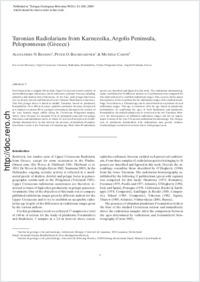Turonian radiolarians from Karnezeika, Argolis peninsula, Peloponnesus (Greece)
- Bandini, Alexandre N. Institut de géologie et de paléontologie, Anthropole-Dorigny, Université de Lausanne, Switzerland
- Baumgartner, Peter O. Institut de géologie et de paléontologie, Anthropole-Dorigny, Université de Lausanne, Switzerland
- Caron, Michèle Institut de géologie et de paléotonlogie, Université de Fribourg, Switzerland
-
25.01.2007
Published in:
- Eclogae Geologicae Helvetiae. - 2006, vol. 99, no. Supplement 1, p. S1-S20
Mesozoic
Upper cretaceous
Turonian
Radiolaria
Foraminifera
Tethys
Pelagonian Zone
Argolis Peninsula
Greece
English
Near Karnezeika a roughly 140 m thick Upper Cretaceous section consists of interbedded pelagic limestones, cherts and coarse polymict breccias including ophiolites and shallow water limestones. At the base, pink pelagic limestones rest on deeply altered and fractured Lower Jurassic Pantokrator Limestone. This first pelagic facies is dated as middle Turonian, based on planktonic Foraminifera. Over 100 m of coarse ophiolite-carbonate breccias, interpreted as a channel or canyon fill in a pelagic environment, document the erosion of the Late Jurassic nappe edifice along the Cretaceous Pelagonian margin. Above these breccias, we mesured 16 m of principally pink and red pelagic limestones and radiolarian cherts, in which we recovered well-preserved radiolarians discussed here. In this interval, the presence of planktonic Foraminfera allows to state a late Turonian to Coniacian age. More than 40 radiolarian species are described and figured in this work. The radiolarian chronostratigraphy established by 10 different authors in 11 publications was compared for this study and used to establish radiolarian ranges. This exercise shows major discrepancies between authors for the radiolarian ranges of the studied assemblage. Nevertheless, a Turonian age can be stated based on a synthesis of cited radiolarian ranges. This age is consistent with the age based on planktonic foraminifera. In combining the ages of both Radiolaria and planktonic Foraminifera, the studied samples can be restricted to the late Turonian. However, the discrepancies of published radiolarian ranges call for an urgent, major revision of the Late Cretaceous radiolarian biochronology. The integration of planktonic foraminifera with radiolarians may greatly enhance biochronologic resolution in sections where both groups occur.
- Faculty
- Faculté des sciences et de médecine
- Department
- Département de Géosciences
- Language
-
- English
- Classification
- Earth sciences
- License
-
License undefined
- Identifiers
-
- RERO DOC 7844
- DOI 10.1007/s00015-006-0605-2
- Persistent URL
- https://folia.unifr.ch/unifr/documents/300321
Statistics
Document views: 175
File downloads:
- pdf: 178
